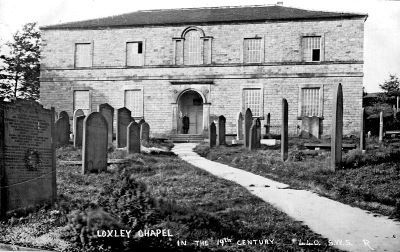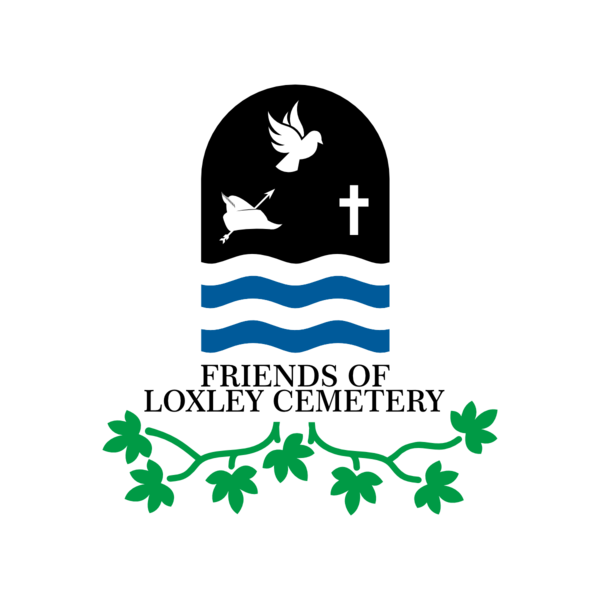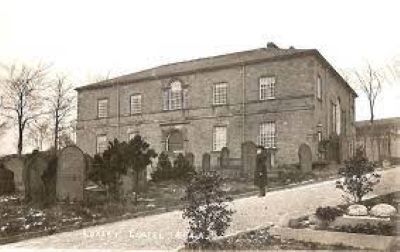
Loxley United Reformed Church
1787: constructed at a cost of £1,000 by some of the worshippers at the Church of St Nicholas, Bradfield. According to a newspaper article in the early 1900s, Rev. A. Benjamin Greaves, an evangelical curate at St Nicholas, was about to be dismissed but he was a popular speaker and his parishioners wanted him to stay in the area, so they raised the money to build the Loxley Congregational Chapel.
The chapel was set back 100 metres from Loxley Road and had the look of a large house constructed from squared gritstone, with Venetian windows. But for some reason it was constructed without an east window and the local bishop refused to consecrate it because of this.
The chapel could hold up to 1000 worshippers; the Rev. Greaves preached there until he moved to preach at Stoney Middleton in Derbyshire. For some time he combined morning services at St. Martin's Chapel in Stoney Middleton, with afternoon services at Loxley Chapel - a long ride on horseback.
Rev. Greaves was succeeded by Rev. Flockton (Church of England), appointed by the mortgagee.
1798: was being rented by Protestant Dissenters or Independents. They changed its name to the Loxley Independent Church when they subsequently bought the building, which was sold by auction for £315.
1799: baptisms commenced in the church.
1802: Rev. Daniel Dunkerley, from Stockport. He died after a pastorate of eighteen years, and was buried in the cemetery.
1806: earliest recorded burial at Loxley Church, that of Elias Crapper.
1821: Rev. David Dunkerley (no relation to Daniel Dunkerley).
1826: Rev. John Cullen
1830: Rev. David Dunkerley (second spell)
1833: Rev. John Hanson, known as the 'Vicar of Loxley'.
1851: various preachers
1854: Rev. Thomas France. He died in November 1898, aged 83. Parishioners placed a remembrance tablet to him in the church.
1855: a new school-room and minister's house was built. A former Lord Mayor of Sheffield laid the stone re new school room and minister's house. At this time the church was well attended; the Religious Census of 1851 reports that it had an afternoon congregation of 200.
1864: victims of the Sheffield Flood were buried in churchyard, among whom were members of the following families - Armitage, Bower, Crownshaw, Denton, Bates, Hudson and Chapman.
1872: Henry Tingle Wilde was christened in the church. He later became the Chief Officer of the Titanic.
1875: the burial ground at the west end of the chapel was extended and trees planted.
1889: Rev. John Lee. A plaque was erected on inner wall of chapel in remembrance of the Rev. John Lee, and his wife Eileen.
1890: the building was restored by the architect (and Loxley Chapel deacon) George Arnold Wilde (1841-1914). George was the uncle of Henry Tingle Wilde mentioned above.
1891: the chapel reopened, with Rev. John Calvert of the Zion Chapel, Attercliffe, conducting the service.
1906: a further extension to the graveyard was made.
1914: Rev. F. T. Leaton.
1920: Rev. A. McKittrick.
1926: Rev. H.S. Shepherd.
1939: Rev. Robert West.
1946: Rev. F. Mares.
1951: Rev. F.W. Nicholls.
1967: interior of chapel redecorated, and 58 windows replaced.
1969: Rev. David Megson, minister at Hillsborough and Worrall, had oversight at Loxley Chapel.
1972: the name of the church was changed again, to the Loxley United Reformed Church, due to the formation of the United Reformed Church.
1985: listed by Historic England as Grade II* and placed on the At Risk register (see the entry for Loxley United Reformed Church).
1989: building damaged by heavy storms and closed temporarily.
1990: reopened following repair work.
1992: last service held due to falling numbers attending, burial ground remained in use. Although a listed building, the church was neglected and subject to vandalism.
1996: chapel and burial ground sold to private developer.
2016: on 17 August 2016 the church caught fire and was severely damaged by the flames. The fire was attended by three fire engines and was put out within hours, however the building was completely gutted, losing its roof and first floor and all its fitments. It now stands open to the elements.

